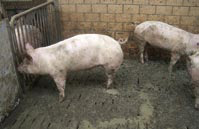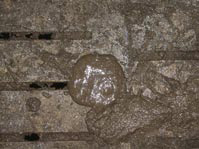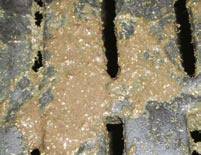4.3.2 What does the diarrhoea in Ileitis look like?
The diarrhoea is generally moderate, with loose pasty stools of normal colour. In many cases, the degree of loose faeces seen is a sloppy, poorly formed stool, resembling cow faeces or wet cement. In more severe cases, the faeces may become more watery and have a liquid sloppy texture. There may be some undigested food particles in the faeces.

Picture 4.3.2 a (by H. Voets)
Group of pigs with diarrhoea on the floor of the pens in the Grower-finisher stages.
The food format the pigs are using – pellets, meal-form, liquid-form, etc. – and the type of feed components – wheat, barley, corn, soy, fish-meal, etc. – seems to have no real influence on the development of the disease. It is important to note the lack of blood or sticky grey mucus within the diarrhoea faeces from pigswith the chronic form of Ileitis. If these characteristics occur, they are associated with other diseases, such as acute proliferative enteropathy (see left column) or swine dysentery (see chapter 4.4.3).

Picture 4.3.2 b (by T. Pabst)
Close up examination of the faeces from pigs with Ileitis: See loose sloppy faeces, resembles cow faeces. No blood or mucus is present.

Picture 4.3.2 c (by S. Lange)
Close-up examination of the faeces from a pig with more severe Ileitis: The diarrhoea can become sloppier and more watery in severe cases. There is some feed material evident in the faeces, because the disease causes reduced digestion of food particles in the intestine.
The type of diarrhoea caused by Lawsonia intra-cellularis is fairly distinctive – diarrhoea caused by Escherichia coli is much more watery and yellow and occurs in pigs normally 1 to 2 weeks after weaning; diarrhoea caused by Brachyspira hyodysenteria and related Brachyspira agents occurs at the same age of pigs as Ileitis, but typically has some fresh blood and mucus material present in the stool, due to increased lesion development in the large intestine.
© Boehringer Ingelheim Animal Health GmbH, 2006
All rights reserved. No part of this Technical Manual 3.0 may be reproduced or transmitted in any form or by any means, electronic or photocopy, without permission in writing from Boehringer Ingelheim Animal Health GmbH.






